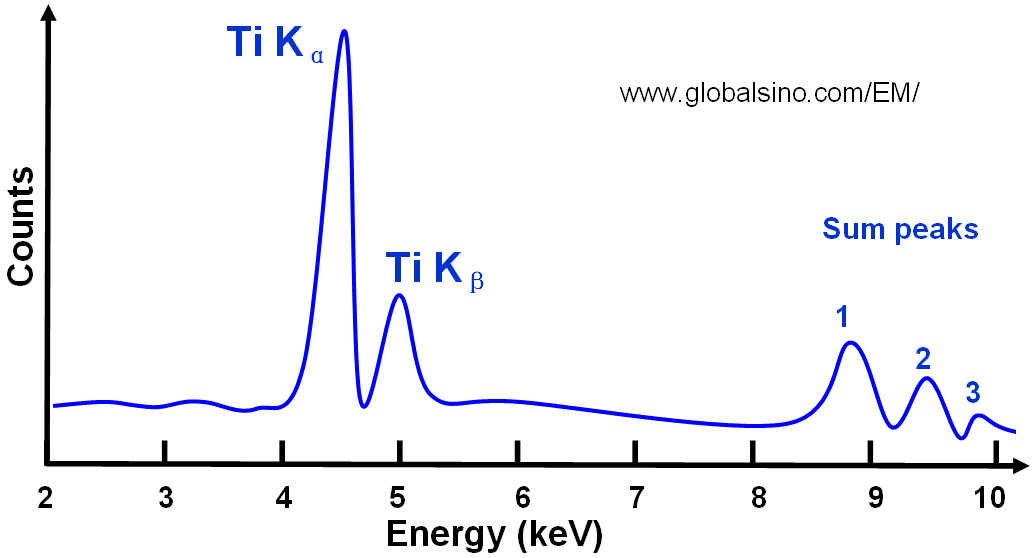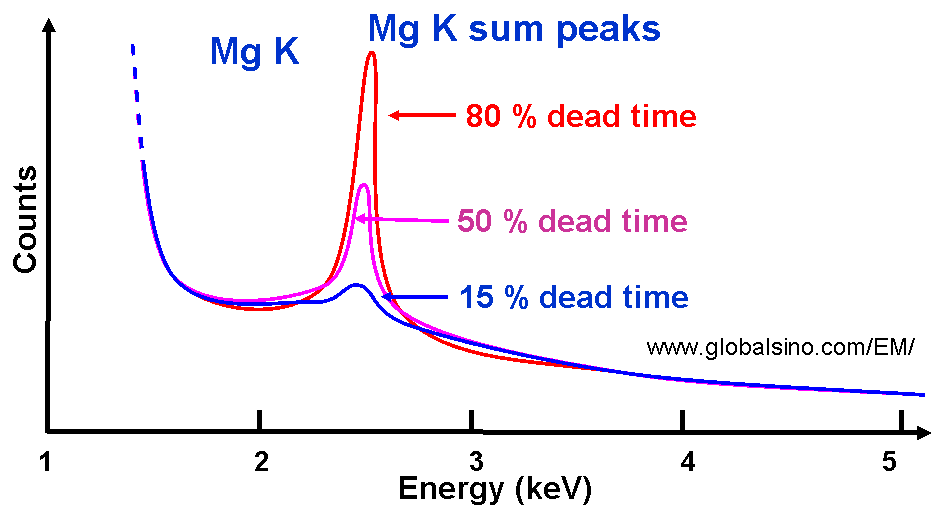| In x-ray measurements (e.g. EDS), a phenomenon, representing peak pileup, occurs where two events from high-intensity peaks arrive in the pulse processing electronic instantaneously, so that the pileup inspector cannot recognize them as two events, and thus they are not discriminated by the pulse pile-up rejection electronics, resulting in a false peak at the sum of the two X-ray energies. Therefore, the signal pulse created and measured is the sum of the two x-ray energies, forming a new peak. In other words, the pile-up develops if two or more X-ray quanta are registered within a short time interval in the detector and the fast channel of signal processing unit cannot differentiate between them any longer. Note that such sum (also called coincidence) peaks may be present occasionally, although this is not common.
This specific form of peak pileup is called “sum peak”. Figure 3803a shows the schematic illustration of the most intense sum peaks of Ti, in which the top-most intense peak (1) is from the sum of two Ti Kα events. The smallest peak (3), from the sum of two Ti Kβ events is only visible when the parent peak is very intense. The sum peaks are not only obtained from the events from the same elements but also from the events from different elements. For instance, if an x-ray photon with energy of 1.74 keV is from Si Kα excitation and an x-ray photon with energy of 1.487 keV from Al Kα excitation, a peak with energy of ~3.23 KeV is read out as a sum peak.

Figure 3803a. Schematic illustration of the most intense sum peaks of Ti.
Figure 3803b shows the schematic illustration of dependence of sum peak intensities on different dead times.

Figure 3803b. Schematic illustration of dependence of sum peak intensities on different dead times. |
Table 3803 shows the effect of processing time on spectral parameters. The most important factor in avoiding the artificial sum peaks is the speed of the processor discrimination circuits. The analyst can reduce such effect by reducing the count rate and thus the X-ray signal strength. The software of many modern EDS systems is designed to recognize and flag escape and sum peaks.
Table 3803. Pile up
continuum and sum peaks.
| Characteristic |
Peak width (FWHM) |
Pile up
continuum |
Sum peaks |
| Short |
Processing time |
Wide peaks |
|
Less |
| Long |
Narrow peaks |
|
More |
| |
Count rate |
|
Occurs at high count rates |
|
| High |
|
Pile up
continuum can appear as a tail on
the high energy side of peaks |
May appear at
the end of the tail |
| X-ray photons |
|
Significant for high energy photons |
|
The intensity of sum peak can be controlled by operating at low deadtime through the selection of the beam current
and/or the EDS solid angle. For deadtime <10%, sum peaks are usually of negligible intensity. In practice, the input count rate of EDS detector is normally selected so that the system deadtime is generally less than 30%-50% in order to minimize the effects of pulse pileup and peak distortion.
The following techniques can be used to reduce the occurrence of sum peaks:
- Lower the Beam Current: Reducing the beam current decreases the X-ray intensity, reducing the chance of simultaneous detection events.
- Reduce the Detector Count Rate: Optimizing the detector’s dead time (the time it needs to process each detected photon) can prevent the simultaneous detection of multiple X-rays.
- Use a Higher-Resolution Detector: Advanced detectors with faster processing speeds can separate closely timed X-ray events more effectively.
On the other hand, sum peaks are generally more pronounced in SEM EDS than in TEM EDS due to the differences in electron beam interaction volume, X-ray generation rate, and typical operating conditions between the two techniques:
- Interaction Volume and X-ray Generation:
- In SEM, the electron beam interacts with a larger volume of the sample, which often generates a higher number of X-rays. With more X-rays being produced simultaneously, the probability of two X-rays arriving at the detector at nearly the same time increases, leading to more frequent sum peaks.
- In TEM, the sample is extremely thin, so the interaction volume is much smaller. This results in fewer X-rays being generated, thus reducing the probability of simultaneous X-ray events that cause sum peaks.
- X-ray Count Rate:
- SEMs often operate at higher beam currents to analyze bulk samples, which can lead to high count rates at the detector. A high count rate increases the chance of multiple X-ray photons arriving simultaneously, causing sum peaks to appear in the spectrum.
- In TEM, the count rate is generally lower because the thin samples produce fewer X-rays, and the beam current is typically lower for EDS measurements. This reduces the chances of simultaneous X-ray events, resulting in fewer or less intense sum peaks.
- Detection Efficiency:
- In SEM, high concentrations of certain elements can lead to a large number of characteristic X-rays, increasing the probability of sum peaks. In addition, SEM EDS setups may not be optimized for low count rates as TEM setups often are, so sum peaks are more likely to occur and appear more intense.
- TEM setups, especially when optimized for EDS, often aim for low count rates to improve spectral quality and avoid artifacts, such as sum peaks. Due to the lower X-ray generation rate, sum peaks tend to be less intense or even negligible.
|
